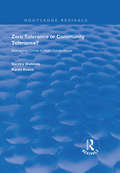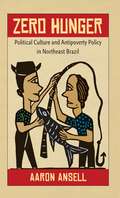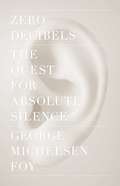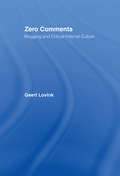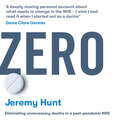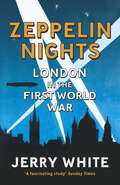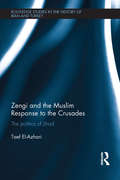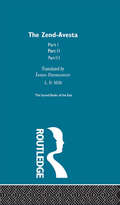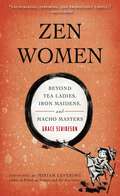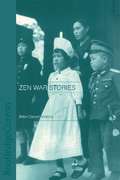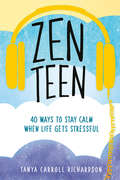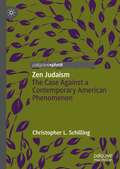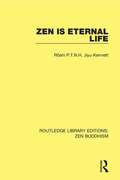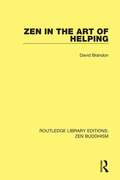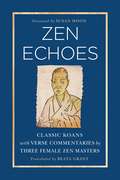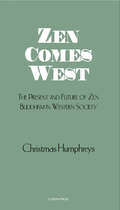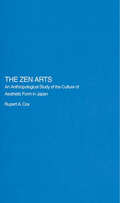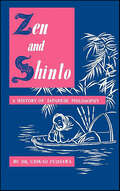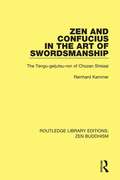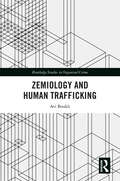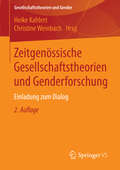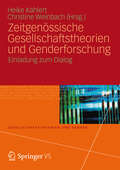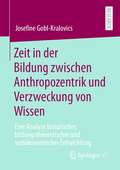- Table View
- List View
Zero Tolerance or Community Tolerance?: Managing Crime in High Crime Areas (Routledge Revivals)
by Sandra Walklate Karen EvansFirst published in 1999, this volume presents arguments which compare two inner-city wards of Salford and look to introduce such a subtlety to the understanding of the management of crime in high crime communities and derive from a longitudinal research study which took place over a two and a half year period. Between 1994 and 1996, researchers based at the University of Salford and the University of Keele embarked on research into two similarly structured neighbourhoods within the city of Salford in the North of England. This research set out to situate an understanding of the risk from and fear of crime in a comparative, urban context – to uncover how people who live, work and go to school in designated ‘high-crime’ areas manage their routine daily lives and construct their own responses to ‘risk of’ and ‘fear of’ crime. The authors go on to highlight the similarities between these wards and other wards with which they have a clear resonance across Britain.
Zero Hunger
by Aaron AnsellWhen Luiz Inacio Lula da Silva of Brazil's Workers' Party soared to power in 2003, he promised to end hunger in the nation. In a vivid ethnography with an innovative approach to Brazilian politics, Aaron Ansell assesses President Lula's flagship antipoverty program, Zero Hunger (Fome Zero), focusing on its rollout among agricultural workers in the poor northeastern state of Piaui. Linking the administration's fight against poverty to a more subtle effort to change the region's political culture, Ansell rethinks the nature of patronage and provides a novel perspective on the state under Workers' Party rule.Aiming to strengthen democratic processes, frontline officials attempted to dismantle the long-standing patron-client relationships--Ansell identifies them as "intimate hierarchies--that bound poor people to local elites. Illuminating the symbolic techniques by which officials attempted to influence Zero Hunger beneficiaries' attitudes toward power, class, history, and ethnic identity, Ansell shows how the assault on patronage increased political awareness but also confused and alienated the program's participants. He suggests that, instead of condemning patronage, policymakers should harness the emotional energy of intimate hierarchies to better facilitate the participation of all citizens in political and economic development.
Zero Degrees: Geographies of the Prime Meridian
by Charles W. WithersCharles Withers explains how the choice of Greenwich to mark 0° longitude solved problems of global measurement that had engaged geographers, astronomers, and mariners since ancient times. This history is a testament to the power of maps, the challenges of global measurement, and the role of scientific authority in creating the modern world.
Zero Decibels
by George M FoyHave our noise-soaked lives driven us mad? And is absolute silence an impossible goal--or the one thing that can save us? A lively tale of one man's quest to find the grail of total quiet.---" I don't know at what point noise became intolerable for me," George Michelsen Foy writes as he recalls standing on a subway platform in Manhattan, hands clamped firmly over his ears, face contorted in pain. But only then does Foy realize how overwhelmed he is by the city's noise and vow to seek out absolute silence, if such an absence of sound can be discovered.Foy begins his quest by carrying a pocket-sized decibel meter to measure sound levels in the areas he frequents most--the subway, the local café, different rooms of his apartment--as well as the places he visits that inform his search, including the Parisian catacombs, Joseph Pulitzer's "silent vault," the snowy expanses of the Berkshires, and a giant nickel mine in Canada, where he travels more than a mile underground to escape all human-made sound. Along the way, Foy experiments with noise-canceling headphones, floatation tanks, and silent meditation before he finally tackles a Minnesota laboratory's anechoic chamber that the Guinness Book of World Records calls "the quietest place on earth," and where no one has ever endured even forty-five minutes alone in its pitch-black interior before finding the silence intolerable.Drawing on history, science, journalistic reportage, philosophy, religion, and personal memory, as well as conversations with experts in various fields whom he meets during his odyssey, Foy finds answers to his questions: How does one define silence? Did human beings ever experience silence in their early history? What is the relationship between noise and space? What are the implications of silence and our need for it--physically, mentally, emotionally, politically? Does absolute silenceactually exist? If so, do we really want to hear it? And if we do hear it, what does it mean to us?According to the Environmental Protection Agency, 30 million Americans suffer from environment-related deafness in today's digital age of pervasive sound and sensory overload. Roughly the same number suffer from tinnitus, a condition, also environmentally related, that makes silence impossible in even the quietest places. In this respect, Foy's quest for silence represents more than a simple psychological inquiry; both his queries and his findings help to answer the question "How can we live saner, healthier lives today?"Innovative, perceptive, and delightfully written, Zero Decibels will surely change how we perceive and appreciate the soundscape of our lives.
Zero Comments: Blogging and Critical Internet Culture (Kultur- Und Medientheorie Ser.)
by Geert LovinkIn Zero Comments, internationally renowned media theorist and 'net critic' Geert Lovink revitalizes worn out concepts about the Internet and interrogates the latest hype surrounding blogs and social network sites. In this third volume of his studies into critical Internet culture, following the influential Dark Fiber and My First Recession, Lovink develops a 'general theory of blogging.' He unpacks the ways that blogs exhibit a 'nihilist impulse' to empty out established meaning structures. Blogs, Lovink argues, are bringing about the decay of traditional broadcast media, and they are driven by an in-crowd dynamic in which social ranking is a primary concern. The lowest rung of the new Internet hierarchy are those blogs and sites that receive no user feedback or 'zero comments'. Zero Comments also explores other important changes to Internet culture, as well, including the silent globalization of the Net in which the West is no longer the main influence behind new media culture, as countries like India, China and Brazil expand their influence and looks forward to speculate on the Net impact of organized networks, free cooperation and distributed aesthetics.
Zero: Eliminating unnecessary deaths in a post-pandemic NHS
by Jeremy HuntHow many avoidable deaths are there in the NHS every week?150.What figure should we aim for?Zero.The NHS is the pride of Britain. It's an army of highly skilled and talented healthcare professionals, armed with the most cutting-edge therapies and medicines, and a budget bigger than the GDP of most countries in the world.Yet avoidable failures are common. And the result is tragic deaths up and down the country every day.Jeremy Hunt, the longest-serving Health Secretary in history, knows exactly what the cost is. In the letters he received from bereaved family members, he was constantly confronted by the heart-breaking reality of slip-ups and mistakes.There is increasing conflict between public pride in the NHS and the exhausted daily reality for many doctors and nurses, now experiencing burnout in record numbers. Waiting lists are up, staffing numbers inadequate, and all the while an ageing population and medical advances increase both demand and expectations. With pressures like these, is it surprising that mistakes start to creep in?This great British institution is crying out for renewal. In Zero, taking the broadest approach, thinking through everything from staffing to technology, budgets to culture, Hunt presents a manifesto for that renewal.Mistakes happen. But nobody deserves to become a statistic in an NHS hospital. That's why we need to aim for zero.
Zeppelin Nights: London in the First World War
by Jerry White‘Zeppelin Nights is social history at its best… White creates a vivid picture of a city changed forever by war’ The Times2018 marks the centenary of the end of the First World War. In those four decisive years, London was irrevocably changed. Soldiers passed through the capital on their way to the front and wounded men were brought back to be treated in London’s hospitals. At night, London plunged into darkness for fear of Zeppelins that raided the city. Meanwhile, women escaped the drudgery of domestic service to work as munitionettes. Full employment put money into the pockets of the poor for the first time. Self-appointed moral guardians seize the chance to clamp down on drink, frivolous entertainment and licentious behaviour. Even against a war-torn landscape, Londoners were determined to get on with their lives, firmly resolved not to let Germans or puritans spoil their enjoyment. Peopled with patriots and pacifists, clergymen and thieves, bluestockings and prostitutes, Jerry White’s magnificent panorama reveals a battle-scarred yet dynamic, flourishing city.‘Jerry White's name on a title page is a guarantee of a lively, compassionate book full of striking incidents and memorable images… This is a fast-paced social history that never stumbles… A well-orchestrated polyphony of voices that brings history alive’ Guardian
Zengi and the Muslim Response to the Crusades: The politics of Jihad (Routledge Studies in the History of Iran and Turkey)
by Taef El-AzhariZengi gained his legacy as the precursor to Saladin. While Zengi captured Edessa, Saladin would capture Jerusalem, and both leaders fought to establish their own realms. However, Zengi cannot be fully understood without an examination of his other policies and warfare and an appreciation of his Turkmen background, all of which influenced his fight against the Crusades. Zengi and the Muslim Response to the Crusades: The politics of Jihad, provides a full and rich picture of Zengi’s career: his personality and motives; his power and ambition; his background and his foundation of a dynasty and its contribution, along with other dynasties, to a wider, deeper Turkification of the Middle East; his tools and methods; his vision, calamities and achievements; and how he was perceived by his contemporaries and modern scholars. Examining primary Muslim and non-Muslim sources, this book’s extensive translations of original source material provides new insight into the complexities of Zengi’s rule, and the politics of jihad that he led and orchestrated during the Crusades. Providing deeper understanding of Islamic history through a close examination of one of its key figures, this book will be a valuable resource for students and scholars interested in Muslim history and the Crusades in general.
The Zend Avesta: The Vendîdâd, Translated By James Darmesteter (Sacred Books Of The East Ser.)
by Frederich Max MullerThis is a subset of the Sacred Books of the East Series which includes translations of all the most important works of the seven non-Christian religions which have exercised a profound influence on the civilizations of the continent of Asia. The works have been translated by leading authorities in their field. Parts I, II and III.
Zen Women
by Miriam Levering Grace SchiresonThis landmark presentation at last makes heard the centuries of Zen's female voices. Through exploring the teachings and history of Zen's female ancestors, from the time of the Buddha to ancient and modern female masters in China, Korea, and Japan, Grace Schireson offers us a view of a more balanced Dharma practice, one that is especially applicable to our complex lives, embedded as they are in webs of family relations and responsibilities, and the challenges of love and work. Part I of this book describes female practitioners as they are portrayed in the classic literature of "Patriarchs' Zen"--often as "tea-ladies," bit players in the drama of male students' enlightenments; as "iron maidens," tough-as-nails women always jousting with their male counterparts; or women who themselves become "macho masters," teaching the same Patriarchs' Zen as the men do. Part II of this book presents a different view--a view of how women Zen masters entered Zen practice and how they embodied and taught Zen uniquely as women. This section examines many urgent and illuminating questions about our Zen grandmothers: How did it affect them to be taught by men? What did they feel as they trying to fit into this male practice environment, and how did their Zen training help them with their feelings? How did their lives and relationships differ from that of their male teachers? How did they express the Dharma in their own way for other female students? How was their teaching consistently different from that of male ancestors? And then part III explores how women's practice provides flexible and pragmatic solutions to issues arising in contemporary Western Zen centers.
Zen War Stories (Routledge Critical Studies in Buddhism)
by Brian VictoriaFollowing the critically acclaimed Zen at War (1997), Brian Victoria explores the intimate relationship between Japanese institutional Buddhism and militarism during the Second World War.Victoria reveals for the first time, through examination of the wartime writings of the Japanese military itself, that the Zen school's view of life and death was deliberately incorporated into the military's programme of 'spiritual education' in order to develop a fanatical military spirit in both soldiers and civilians. Furthermore, that D. T. Suzuki, the most famous exponent of Zen in the West, is shown to have been a wartime proponent of this Zen-inspired viewpoint which enabled Japanese soldiers to leave for the battlefield already resigned to death. Victoria takes us onto the naval battlefield in the company of warrior-monk and Rinzai Zen Master Nakajima Genjô. We view the war in China through the eyes of a Buddhist military chaplain. The book also examines the relationship to Buddhism of Japan's seven Class-A war criminals who were hung by the Tokyo War Crimes Tribunal in 1948.A highly controversial study, this book will be of interest, first and foremost, to students of Zen as well as all those studying the history of this period, not to mention anyone concerned with the perennial question of the 'proper' relationship between religion and the state.
Zen Teen: 40 Ways to Stay Calm When Life Gets Stressful
by Tanya Carroll RichardsonA warm and relatable teen guide to reducing anxiety, depression, and panic while developing resilience and confidence with 40 tips and tricks that guide, support, and inspire teens to keep calm and stay mindfulIn the last decade, studies have reported a drastic rise in teens who experience anxiety, panic, and an inability to cope with the pressures of daily life. As mental health challenges become less stigmatized, young people are more likely than ever before to know how to identify their feelings and ask for help. Even celebrity teen icons like Selena Gomez are "coming out" as anxiety sufferers.Zen Teen addresses this epidemic with powerful coping mechanisms and creative tools-including two fun quizzes, tons of engaging exercises and a cool playlist-designed for the teenage mind. With topics like "The Unique Genius of You" and "Rock-Star Rituals," Tanya Carroll Richardson prompts teens to get calm by engaging in mindful tasks like identifying gurus, tapping into warrior energy, mastering meditation, practicing realistic optimism, becoming a self-awareness samurai, learning to surrender, finding a spirit animal, expressing challenging emotions, living with loving-kindness, protecting the planet, and making vision boards that embrace "the Tao of Cool."Smart and fresh, Zen Teen helps teens thrive while navigating and managing the pressures of everyday life.
Zen Judaism: The Case Against a Contemporary American Phenomenon
by Christopher L. SchillingContemporary Judaism is transforming, especially in America, from a community experience to more of a do-it-yourself religion focused on the individual self. In this book Christopher L. Schilling offers a critique of this transformation. Schilling discusses problematic aspects of Jewish mindfulness meditation, and the relationship between Judaism and psychedelics, proceeding to explore the science behind these developments and the implications they have for Judaism.
Zen is Eternal Life (Routledge Library Editions: Zen Buddhism)
by Roshi P.T.N.H. Jiyu-KennettThis book, first published as Selling Water by the River in 1972, is a practical and inspirational manual for all who wish to practice Zen. Rōshi P.T.N.H. Jiyu-Kennett, the founder and former abbess of Shasta Abbey, expertly combines an introduction to the basic tenets of Buddhism with original translations of the teachings of Zen Masters Dōgen and Keizan.
Zen in the Art of Helping (Routledge Library Editions: Zen Buddhism)
by David BrandonA succinct, uncompromising study of what it means to help other people, this book, first published in 1978, examines the helping process in the light of the principles of Zen Buddhism. Emphasizing the Zen precepts of true compassion, newness and Taoistic change, it explains how a helper can break down the artificial barriers that serve to separate people and hinder the helping process. As the teachings of Zen demonstrate, real compassion involves a selflessness and respect that can bring helper and helped together.
Zen Echoes: Classic Koans with Verse Commentaries by Three Female Chan Masters
by Beata Grant Susan MoonThe voices of three female Zen masters reverberate in this much-needed collection.Too often the history of Zen seems to be written as an unbroken masculine line: male teacher to male student. In this timely volume, Beata Grant shows us that women masters do exist—and have always existed. Zen Echoes is a collection of classic koans from Zen’s Chinese history that were first collected and commented on by Miaozong, a twelfth-century nun so adept that her teacher, the legendary Dahui Zonggao, used to tell other students that perhaps if they practiced hard enough, they might be as realized as her. Nearly five hundred years later, the seventeenth-century nuns Baochi and Zukui added their own commentaries to the collection. The three voices—distinct yet harmonious—remind us that enlightenment is at once universal and individual. In her introduction to this shimmering translation, Professor Grant tells us that the verses composed by these women provide evidence that “in a religious milieu made up overwhelmingly of men, there were women who were just as dedicated to Chan practice, just as advanced in their spiritual realization, and just as gifted at using language to convey that which is beyond language.”
Zen Comes West
by Christmas HumphreysZen Buddhism was founded in China in the 6th century, and its direct path to Enlightenment first came west in 1927 with D. T. Suzuki's first Essays. This work guides the reader towards Zen teaching in practice and theory, and to provide material for further explorations into its meditative experience.
The Zen Arts: An Anthropological Study of the Culture of Aesthetic Form in Japan (Royal Asiatic Society Books)
by Rupert CoxThe tea ceremony and the martial arts are intimately linked in the popular and historical imagination with Zen Buddhism, and Japanese culture. They are commonly interpreted as religio-aesthetic pursuits which express core spiritual values through bodily gesture and the creation of highly valued objects. Ideally, the experience of practising the Zen arts culminates in enlightenment.This book challenges that long-held view and proposes that the Zen arts should be understood as part of a literary and visual history of representing Japanese culture through the arts. Cox argues that these texts and images emerged fully as systems for representing the arts during the modern period, produced within Japan as a form of cultural nationalism and outside Japan as part of an orientalist discourse.Practitioners' experiences are in fact rarely referred to in terms of Zen or art, but instead are spatially and socially grounded. Combining anthropological description with historical criticism, Cox shows that the Zen arts are best understood in terms of a dynamic relationship between an aesthetic discourse on art and culture and the social and embodied experiences of those who participate in them.
Zen and Shinto: A History of Japanese Philosophy
by Dr. Chikao FujisawaThis history of Japanese philosophical traditions underscores the importance of Zen and Shinto to the development of Japanese culture. How do the Japanese talk about their native philosophy, Shinto, so many years after the Western Allies abolished it as a state religion? What is its relationship to Buddhism, and particularly to Zen? How modern can this very ancient creed ever be? These are some of the questions considered in this analytic work by Dr. Chikao Fujisawa, who specializes in the study of traditional Japanese philosophy and its effect on modern society. Fujisawa&’s work is not only a survey of Zen and Shinto, but also an impassioned plea to restore Shinto as the very substance of Japanese life and thought. At the same time, Zen and Shinto offers new insight into the depth and vitality of Japanese culture, demonstrating its remarkable capacity to assimilate foreign thought and ideas, and thus contribute to the world&’s hope for permanent peace.
Zen and Confucius in the Art of Swordsmanship: The 'Tengu-geijutsu-ron' of Chozan Shissai (Routledge Library Editions: Zen Buddhism)
by Reinhard KammerThe sword has played an important role in the Japanese consciousness since ancient times. The earliest swords, made of bronze or stone, were clearly, by their design and form, used for ritualistic purposes rather than as weapons. Later, swords were associated only with the warrior class, and lack of physical strength and battle experience was compensated for by handling the sword in a way that was technically expert. Besides this sacred and artistic status, swordsmanship also acquired a philosophical reinforcement, which ultimately made it one of the Zen ‘ways’. Zen Buddhism related the correct practice of swordsmanship to exercises for attaining enlightenment and selfishness, while Confucianism, emphasizing the ethical meaning, equated it to service to the state. This classic text, first published in English in 1978, includes a history of the development and an interpretation of Japanese swordsmanship, now esteemed as an art and honoured as a national heritage. It describes in detail the long, intensive and specialized training and etiquette involved, emphasizing and explaining the importance of both Zen and Confucian ideas and beliefs.
Zemiology and Human Trafficking (Routledge Studies in Organised Crime)
by Avi BoukliFollowing the rise of the zemiological movement, the concept of social harm has attracted a great deal of scholarly attention. Using this perspective, a number of scholars have sought to remove the constraining brackets surrounding criminological investigation in order to broaden its legitimate parameters of study and incorporate a wider range of un-criminalized and hidden harms. This book expands the literature on social harm by applying the concept of zemia to human trafficking investigations in Europe, North America, and Africa. This book draws attention not only to various structurally imbedded harms, but also to the wider consequences of such harms. Drawing on a range of international legal cases on trafficking, this book offers a new direction in criminological and zemiological thinking and a reimagining of criminal justice responses to harm.
Zeitgenössische Gesellschaftstheorien und Genderforschung, 2. Auflage
by Christine Weinbach Heike KahlertDer Band will am Beispiel ausgewählter zeitgenössischer Gesellschaftstheorien, die bereits mehrheitlich auch in der Genderforschung rezipiert werden, zum stärker systematisierten Dialog zwischen Genderforschung und Gesellschaftstheorien einladen. Unter Bezugnahme auf gemeinsame Leitkategorien berücksichtigen die Beiträge den Entstehungskontext der behandelten Gesellschaftstheorien sowie den zeitdiagnostisch relevanten Rezeptionsrahmen und entwickeln Perspektiven, die Gender als selbstverständlichen Bestandteil von Gesellschaft(stheorien) in das jeweilige Theoriegerüst einflechten. Dabei werden der Ort von Gender in der jeweiligen Theorie ausgelotet und Ansatzpunkte für den Theorienvergleich wie auch den weiteren Dialog von Gesellschaftstheorien und Genderforschung aufgezeigt. Zielsetzungen sind, Leerstellen der Gesellschaftsanalyse hinsichtlich der komplexen Einbettung der Geschlechterverhältnisse fokussierter zu erarbeiten und Erkenntnisse und Potenziale der Genderforschung gesellschaftstheoretisch rückzubinden. Für die 2. Auflage wurden alle Texte durchgesehen und zum Teil aktualisiert.
Zeitgenössische Gesellschaftstheorien und Genderforschung
by Christine Weinbach Heike KahlertDer Band will am Beispiel ausgewählter zeitgenössischer Gesellschaftstheorien, die bereits mehrheitlich auch in der Genderforschung rezipiert werden, zum stärker systematisierten Dialog zwischen Genderforschung und Gesellschaftstheorien einladen. Unter Bezugnahme auf gemeinsame Leitkategorien berücksichtigen die Beiträge den Entstehungskontext der behandelten Gesellschaftstheorien sowie den zeitdiagnostisch relevanten Rezeptionsrahmen und entwickeln Perspektiven, die Gender als selbstverständlichen Bestandteil von Gesellschaft(stheorien) in das jeweilige Theoriegerüst einflechten. Dabei werden der Ort von Gender in der jeweiligen Theorie ausgelotet und Ansatzpunkte für den Theorienvergleich wie auch den weiteren Dialog von Gesellschaftstheorien und Genderforschung aufgezeigt. Zielsetzungen sind, Leerstellen der Gesellschaftsanalyse hinsichtlich der komplexen Einbettung der Geschlechterverhältnisse fokussierter zu erarbeiten und Erkenntnisse und Potenziale der Genderforschung gesellschaftstheoretisch rückzubinden.
Zeit in der Bildung zwischen Anthropozentrik und Verzweckung von Wissen: Eine Analyse historischer, bildungstheoretischer und soziökonomischer Entwicklung
by Josefine Gobl-KralovicsZeit als unverzichtbare Bedingung für personale Bildungsprozesse wird heute durch sogenannte effiziente, ökonomisch orientierte Beschleunigungskonzepte, als strategische Klammer der Verzweckung von Wissen instrumentalisiert. Selbstbestimmte Bildung im Rahmen adäquater Zeithorizonte gerät immer mehr in Gefahr verstellt zu werden. Josefine Gobl-Kralovics zeigt anhand dieser kritische Situation, auch mittels Einbeziehung und Analyse des Begriffs Anthropozentrik pädagogisch beleuchtet, die Beschleunigung im Widerspruch zur Bildungsaufgabe des Menschen auf, genauso wie drohende Entfremdung als Folge von Fremdbestimmung. Beschleunigung avancierte zum Lebenstempo – Muße scheint dagegen obsolet.
Zeee
by Elizabeth Enright1965 classic children's tale tells the story of Zeee, a fairy who hates people and is constantly in search of a place to live.
